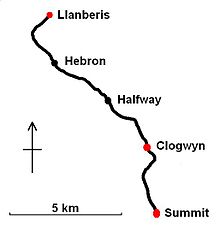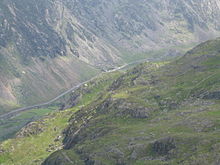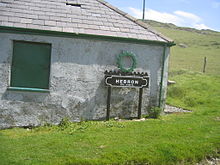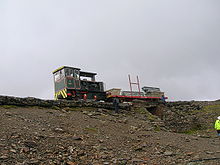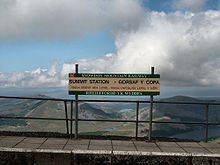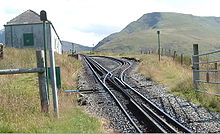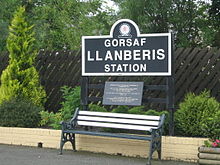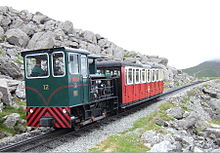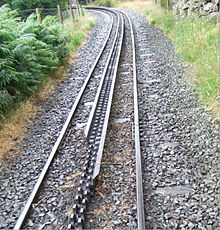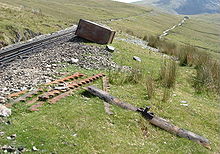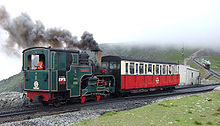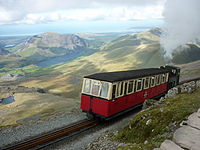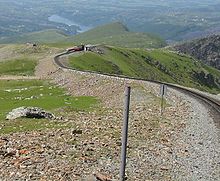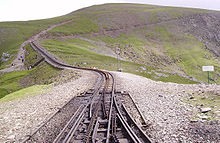- Snowdon Mountain Railway
-
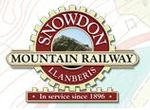
Snowdon Mountain Railway
Rheilffordd yr Wyddfa
Half way up the MountainOverview Type Rack and pinion mountain railway Locale Gwynedd Termini Llanberis
Yr WyddfaOperation Opened 1896 Owner Heritage Great Britain plc[1] Operator(s) Heritage Great Britain plc Technical Line length 4.7 mi (7.6 km) No. of tracks Single track with passing loops Track gauge 800 mm (2 ft 7 1⁄2 in) Minimum radius (?) Rack system Abt[2] Route map Snowdon Mountain Railway Legend
Llanberis 
Waterfall (closed) 
Hebron 
Halfway 
Rocky Valley Halt 
Clogwyn 
Summit The Snowdon Mountain Railway (SMR) (Welsh: Rheilffordd yr Wyddfa) is a narrow gauge rack and pinion mountain railway in Gwynedd, north-west Wales. It is a tourist railway that travels for 4.7 miles (7.6 km) from Llanberis to the summit of Snowdon, the highest peak in England and Wales.[3]
The SMR is the only public rack and pinion railway in the United Kingdom,[4] and after more than 100 years of operation it remains a popular tourist attraction. The line is owned and operated by Heritage Great Britain plc,[5] operators of several other tourist attractions in the United Kingdom.
The railway is operated in some of the harshest weather conditions in Britain, with services curtailed from reaching the summit in bad weather and remaining closed during the winter from November to mid-March. Single carriage trains are pushed up the mountain by either steam locomotives or diesel locomotives. It has also previously used diesel railcars as multiple units.
The SMR was the inspiration for the fictional Culdee Fell Railway, appearing in the story book "Mountain Engines", part of the "The Railway Series" written by the late Reverend W. Awdry. The Railway Series books were the basis for the popular Thomas the Tank Engine and Friends children's television series; as yet however the Culdee Fell Railway has not been included in the televised episodes (though the major characters do have toys based on them).
Contents
History
Construction
The idea of a railway to the summit of Snowdon was first proposed in 1869, when Llanberis was linked to Caernarfon by the London & North Western Railway. No action was taken, as the local landowner, Mr Assheton-Smith, thought a railway would spoil the scenery.
A plan to build a railway to the summit of Snowdon from Rhyd Ddu station on the North Wales Narrow Gauge Railways brought fears that Llanberis would lose its income from tourists, and the Snowdon Mountain Tramway and Hotel Company was formed to build the railway.[2] Mr Assheton-Smith, still the principal landowner in the area, was not a major influence in the company. No Act of Parliament was required, as the line was built entirely on private land obtained by the company, without any need for the power of compulsory purchase. This was unusual for a passenger-carrying railway, and also meant that the railway did not come under the jurisdiction of the Board of Trade.
The railway was constructed between December 1894, when the first sod was cut by Enid Assheton-Smith (after whom locomotive No.2 was named), and February 1896, at a total cost of £63,800 (£5,474,000 as of 2011),[6]. It is said[by whom?] that by April 1895 the earthworks were 50% complete, a sign of the effort put into the construction work as much as of the lack of major earthworks along much of the route.
All tracklaying had to start from one end of the line, to ensure the rack was correctly aligned; so although the first locomotives were delivered in July 1895 very little track was laid until August, when the two large viaducts between Llanberis and Waterfall were completed. Progress up the mountain was then quite rapid, with the locomotives being used to move materials as required. Considering the exposed location and possible effects of bad weather, it is surprising that the first train reached the summit in January 1896. As the fencing and signals were not then ready, the opening was set for Easter.
The line was opened at Easter 1896. In anticipation of this, Colonel Sir Francis Marindin from the Board of Trade made an unofficial inspection of the line on Friday 27 March. This included a demonstration of the automatic brakes. He declared himself satisfied with the line, but recommended that the wind speed be monitored and recorded, and trains stopped when the wind was too strong.
On Saturday 4 April a train was run by the contractor consisting of a locomotive and two coaches. On the final section, the ascending train hit a boulder that had fallen from the side of a cutting and several wheels were derailed. The workmen on the train were able to rerail the carriage and the train continued.
Opening day accident
The railway was officially opened on Monday 6 April, and two trains were dispatched to the summit. On the first return trip down the mountain, possibly due to the weight of the train, locomotive No.1 "Ladas" with two carriages lost the rack and ran out of control. The locomotive derailed and fell down the mountain. A passenger died from loss of blood after jumping from the carriage.[7] After a miscommunication the second downward train hit the carriages of the first, with no fatalities.
An inquiry concluded that the accident had been triggered by post-construction settlement, compounded by excess speed due to the weight of the train. As a result of the inquiry's recommendations the maximum allowed train weight was reduced to the equivalent of 1½ carriages, leading to lighter carriages being bought and used on two-carriage trains. A gripper system was also installed on the rack railway (see Gripper rail section).
Pre war
On 9 April 1897 the line re-opened. This time there were no incidents and the train service continued. Passengers were still carried during the early years of World War II, but they were not permitted at the summit.
Post war
Normal service resumed in 1946. The shortage of coal led to the railway attempting to burn old army boots as fuel. The British Railways Llanberis-Caernarvon line closed to passengers in 1962. In 1983, the summit buildings were transferred to the ownership of Gwynedd County Council. A share issue was made in 1985, primarily to raise money to purchase the first two diesel locomotives. Between 1986 and 1992 the railway company was involved with the airfield and aviation museum in Caernarvon.
Centenary
As part of the Centenary Celebrations the railway held an enthusiasts' weekend in September 1996. This was one of the few occasions when the public were allowed to visit the railway's workshops. Scrap pinion rings were also sold as (rather large) souvenirs. From this time the locomotives were painted in differing liveries, but by 2005 this practice had ended.
Summit building project
In 2006 the cafe at the summit was demolished and construction of a new visitor centre was started. While this construction was taking place passenger trains terminated at Clogwyn, but the line and a works train was still used to transport workers and materials to the project. On some days, however, the train could not reach the summit and the workers had to walk down to Rocky Valley.[8] The new building, 'Hafod Eryri' (loosely translated from Welsh as 'high residence of Snowdonia'[9]), was officially opened by First Minister Rhodri Morgan on 12 June 2009.[8]
Route
The lowland terminus is Llanberis station, at the side of the main road. The railway is a single track line with passing loops. It is 4 miles 1188 yards (7.524 km) long, with an average gradient of 1 in 7.86. The steepest gradient is 1 in 5.5, and this occurs in a number of places. The railway rises a total of 3,140 feet, from 353 feet above sea level at Llanberis to 3,493 feet at Summit station.
- Llanberis station 53°06′59″N 4°07′10″W / 53.1163°N 4.1195°W (353 ft (108 m)) has two platforms. The first stretch of line is uphill at 1 in 50, steep for a main line but shallow compared with the 1 in 6 incline that begins shortly afterwards.
- Waterfall station 53°06′40″N 4°07′36″W / 53.1111°N 4.1266°W is now closed, but the station building remains. It was built to allow visitors to use the train to travel to a spectacular waterfall close to the line. A short distance from Waterfall station is a bridge over the river and a gate. This marks the start of the mountain.
- Hebron station 53°06′17″N 4°07′04″W / 53.1046°N 4.1179°W (1069 ft (326 m)) is named after the nearby 'Hebron' Chapel. It had originally been hoped that agricultural traffic could be carried to and from this station.
- Halfway station 53°05′44″N 4°05′46″W / 53.0956°N 4.0960°W (1641 ft (500 m))as the name suggests, half way along the line and close to the 'Halfway House' on the nearby footpath. A short distance above the station is a path that leads down to the 'Halfway House' cafe.
- Rocky Valley Halt 53°05′20″N 4°05′02″W / 53.0889°N 4.0838°W consists of a narrow platform sheltered by a rocky outcrop to the east. Immediately beyond the platform the line joins the exposed ridge on which it runs for about half a mile.
- Clogwyn station 53°05′03″N 4°04′49″W / 53.0841°N 4.0803°W (2556 ft (779 m)) is located on the exposed ridge and overlooks the Llanberis Pass and the Clogwyn Du'r Arddu cliffs, a popular climbing spot.
- Summit station 53°04′05″N 4°04′42″W / 53.0680°N 4.0783°W (3493 ft (1065 m)) is only 68 feet (20 m) below the summit, which is at 3560 ft (1085 m). The station has two platforms that link directly to the summit building and to a path to the summit.
Operation
The Llanberis complex also houses the company offices, locomotive shed and workshop building. The forecourt has recently been changed from a visitor car park into a cafe/picnic area.
Train control
Traffic and train movements are controlled from Llanberis: communication between Llanberis, Clogwyn and the Summit, as well as to trains' guards, is by two-way radio.
The line has three passing loops, around 15 minutes travelling time apart. Going up the mountain, these are at Hebron, Halfway and Clogwyn stations. The operation of the Hebron and Halfway loops was converted to semi-automatic operation in the early 1990s. The Clogwyn loop is still staffed and retains the original mechanical point levers. Waterfall station had a siding but never a loop, and has been closed for many years.
All three passing loop tracks are on the north-west side of the main running line - this is in general the "downhill" side, where the mountain slopes away from the line. This means that, if required, the line could be easily be converted to double track without the need to cut into the rock face to widen the formation.
Including stops at the passing loops, the train takes an hour to climb to the summit and an hour to descend again, at an average speed of around 5 mph (8 km/h).
Passenger trains normally run from Llanberis to the Summit. The wind speed is measured at Clogwyn Station and used to determine if trains can continue to the summit. Trains terminate at Rocky Valley Halt when the weather is too bad to allow them to proceed safely to the summit.
It is possible for two trains to run together 'on sight', which involves the second train following shortly (more than two minutes but less than five) after the first, and keeping a safe distance throughout the journey. This is known as a 'Doubler'. All platforms and passing loops are long enough to accommodate two trains.
The two Llanberis platforms are dedicated, one for arrivals and the other for departures. Arriving trains empty of passengers then shunt to the other platform. At the Summit station arriving trains generally alternate between the two platforms.
When steam and diesel trains run together, it is normal for the diesel to lead up the mountain. This allows the steam train to enter the departure platform and load at its leisure, while the diesel moves across from the arrival platform from a quick turn-around.
Locomotives spend the whole day with the same carriage. Any locomotive can work with any carriage, although carriage No.10 (the most modern) usually runs with a diesel locomotive.
Passenger traffic
Most passengers are tourists, and travel on a return trip, which typically involves being booked on a specific train for a round trip to the summit, with a half hour break at the top. Down-only journeys can also be made from the Summit and Clogwyn, on a stand-by basis. Most staff at the summit building live there through the summer.
Trains depart from Llanberis Station at regular intervals, up to every 30 minutes at busy times, although trains are only run if a minimum number of tickets have been sold. During the summer when the weather is favourable, most trains are sold out. Passengers are not allowed to leave or join trains at Halfway or Hebron, but they may join down trains at Clogwyn Station if there is space.
Other traffic
The first train of the day is the 'Works train'. This carries supplies, including drinking water and fuel for the generator, to the summit. It also stops at Halfway station to drop off supplies for the cafe. It returns mid-morning with the previous day's rubbish from the summit. The train also carries the permanent way maintenance gang to where they are working. Upon its return to Llanberis, the locomotive from this train (always now a diesel) goes straight into service with a passenger train.
Steam vs. Diesel
For steam-hauled trains, the Llanberis shunt movement includes a trip to the water crane and coaling stage outside the locomotive shed. At Halfway Station steam locomotives also take water from a water crane, fed from a large tank located just above the station. For emergency use another large water tank is situated near Clogwyn Station which can feed two water cranes.
The diesel locomotives (and railcar when available) are used first, with the steam locomotives being used on trains as required. On arrival at Llanberis, diesel-hauled trains run directly from the arrival platform to the departure platform, load and depart within a few minutes, making one trip every two-and-a-half hours. Steam-hauled trains take at least half an hour to transfer from the arrival to the departure platform, thus making no more than one trip every three hours.
The use of diesel locomotives therefore allows more trains to be run with the same number of carriages. By using diesels, the reduction in costs for both operating trains over the line and having them standing between infrequent runs has allowed the operating season to be extended considerably.
It is stated by the management that the vast majority of passengers do not care whether the trains are powered by steam or diesel locomotives. In the late 1980s comparative figures for the diesels against steam locomotives made it clear that they made economic sense.
From 1987 Steam Diesel Round trip fuel costs £51.00 £3.05 Locomotive crew 2 1 Round trips per day 3 4 Daily Maintenance (hours) 1½ ½ - Note: these figures are taken from a talk given by a member of the design team. It is assumed that the fuel costs include the cost of fuel for "lighting up" a steam locomotive, or keeping the fire in overnight, as well as the fuel for a single round trip. For a diesel locomotive, preparation consists only of starting the engine and leaving it to run until sufficient air pressure has been created.
Safety
Train formation
For safety, train formations consist of one locomotive pushing a single carriage up the mountain and leading it down again while the locomotive brakes allow a controlled descent. The carriage is not coupled to the locomotive, as gravity keeps the two in contact, although an electric cable is run between the locomotive and the carriage, which enables a buzzer to be used to signal between the driver and the guard. The cable is designed to pull free if the locomotive and carriage separate. Not being coupled prevents a carriage being dragged down the mountain if a locomotive derailed, as happened in the opening day accident.
Couplings are used during shunting operations as the yard is on level ground (see photograph of No.6 at Llanberis). It was originally intended that each steam locomotive push two carriages to the summit, but this has not been normal practice since 1914.
Gripper rail
Following an accident in 1896, most of the line was fitted with 'gripper rails'. These are fixed to either side of the rack rail and are of an inverted 'L' cross section. A 'gripper' is fitted to each locomotive, which fits around the gripper rails and holds the locomotive to the rails and prevents the pinion coming free from the rack. Although no other Abt rack railways use a gripper system, other rack systems do.
The gripper rails are not fitted in the top and bottom stations, around Llanberis yard, on any pointwork, nor on the less steep lengths of railway just out of Llanberis and near Waterfall. At the beginning of the sections of gripper rail, the ends are staggered and chamfered to help guide the gripper into place.
If a broken rack bar lifts under a locomotive, it can strike the gripper and jam under the train. In such an incident, the gripper has to be cut away in order to rescue the train.
A mechanical failure[clarification needed (details?)] in 1987 could have caused a repeat of the 1896 accident, but the gripper system worked and held the train on the rails - but the rails were lifted off the ground by the locomotive.
Braking systems
All braking is done using the rack and pinion system. Every locomotive and carriage has a pinion, allowing each vehicle to brake itself.
Locomotives and carriages each have a hand brake which operates brake blocks that clasp drums on either side of the pinions. On the steam locomotives the hand brake is applied manually; two identical hand brake levers are fitted, one for the driver and one for the fireman. On the diesel locomotives, the hand brake is applied by a powerful spring and held off by a hydraulic system.
In normal operation for locomotive/carriage trains, on descending and level running, the train is normally braked (service braking) using the locomotive. This uses compression braking - the energy is absorbed by using the cylinders as pumps, then dumping the pressure, similar to a Jake brake - on steam locomotives, hydraulic braking on the diesel locomotives. The diesel-electric railcars are service braked using hydraulic brakes and dynamic braking, during which power is dissipated in roof-mounted resistors, creating a distinct heat shimmer when the vehicles are descending and shortly afterwards. The hand brakes are used to bring a train to a complete stand from low speed, and as a parking brake.
A train or carriage could be brought down the mountain using the hand brake, but this would be an emergency usage, as it would cause significant wear and heat damage.
For increased safety, each vehicle is also fitted with an automatic brake that is triggered if the vehicle exceeds a specific speed, such as a carriage running away or a locomotive engine failure. This system slows the train down using the same brake blocks and drums as the hand brake. The running speed at which the automatic brake comes on is lower for the carriages than the locomotive, to prevent a carriage running into a stationary locomotive further down the track.
The automatic brake works by monitoring the speed using a centrifugal governor connected by gears to a large toothed gear mounted on the pinion axle next to the wheel (i.e. it is not the pinion gear). When the set speed is exceeded a lever on the governor hits a lever on a brake valve, and the brakes operate. The automatic brake can only be released after the train has come to a stop, and the driver has to leave the locomotive to reset the system. On the steam locomotives, steam is applied to a small brake cylinder that acts on the driver's side brakes. On the carriages, the automatic brake is an air brake. On the diesel locomotives, a hydraulic cylinder is used.
It is vitally important that all braking is done in a controlled manner, as any sudden shocks impose very high loads on the rack rail and pinion wheels, and can cause damage.
Rack railway
The line has a track gauge common to other mountain railways of 800 mm (2 ft 7 1⁄2 in). The rails are fastened to steel sleepers.
The line uses the Abt rack system devised by Roman Abt, a Swiss locomotive engineer. The system comprises a length of toothed rail (the rack) between the running rails which meshes with a toothed wheel (the pinion) mounted on each rail vehicle's driving axle. The traditional logo for the railway is a pinion ring engaged on a rack bar. At the stations and passing loops, the real items are mounted on steel frames.
The entire railway is fitted with the rack rail. On sidings and around the yard at Llanberis it comprises a single rack bar, but on the running line, and through all the loops up the mountain, two rack bars are used, mounted side by side with their teeth staggered by half a pitch. This is one of the major features of the Abt system, and helps to reduce the shock of the pinions running along the rack. It also ensures the pinion maintains continuous contact with the rack. The joints between rack bars are also staggered and align with the sleepers[clarification needed] - each sleeper supports the rack rail as well as the running rails.
The locomotive pinions engage the rack and provide all the traction and braking effort - the wheels are free to revolve on the drive axles, to allow for the inevitable difference between the wheel radius and the effective radius of the pinion. The wheels serve only to support and guide the vehicle; if the pinion were missing, handbrake on and locomotive crank locked, the vehicle would still roll down the mountain. (The wheels are not capable of providing useful adhesion on such a gradient, so this is not the disadvantage it might seem.) The two driving axle pinions on a locomotive are mounted with a half a pitch difference between them. Combined with the half pitch difference in the two rack bars, this feature aims to make the transfer of power more continuous, and thus smooth the hauling of the train. In spite of this, the vehicles still suffer from very high levels of vibration.
The rack bars are machine cut from a special quality of steel: the profile is not symmetrical and the bars must be installed the right way round. Bars tend to fracture between the fixings. When spotted these breaks are marked and then supported with wedges until the bar can be replaced. The pinions consist of an outer ring that is easily replaced. This ring is mounted onto a centre disc, and springs between the two reduce shock loads and allow the small movement needed to accommodate joints and curves. The pinion rings have symmetrical teeth and are turned round to double their working life.
Rolling stock
The company has owned a total of eight steam locomotives, five diesel locomotives and three diesel railcars. With the exception of one steam locomotive and one diesel locomotive, all are still extant and on the railway.
History
When the railway was being planned, only the Swiss had significant experience in building rack locomotives, so it was they who won the contract to build the engines for the line. In comparison with some Swiss railways the line is not very steep, and this is reflected in the design of the engines, which are all classified 0-4-2T.
Built specially for the line in 1895 and 1896, Nos. 1 to 5 were manufactured by the Swiss Locomotive and Machine Works of Winterthur. The first locomotives cost £1525. Nos. 1 to 3 were delivered before the line was open and used on construction work. On at least two occasions, trials have been made on oil burners on Nos. 1 to 5, the latest being on No. 2 in the late 1990s.
For most of the time, the railway's steam locomotives have burnt coal. The requirement for the locomotives to have a hot fire burning efficiently for a solid hour has led to problems when "Best Welsh Steam Coal" has not been readily available. During 1978 Nos 2 and 8 ran with oil burners. To hold the fuel oil, a tank was fitted to the roof of each locomotive. The tanks were thin and followed the profile of the roof. In 2000, No.2 was again fitted with an oil burner in an attempt avoid the increasing problems of obtaining suitable coal.
In 1922/1923 a further three locomotives were delivered, becoming Nos. 6 to 8. Although similar to the first engines in terms of size and power, they have a different design. Again all were built by Swiss Locomotive and Machine Works of Winterthur.
When the boilers of Nos. 7 & 8 needed replacing they were withdrawn from service, but no new boilers were bought. This is probably a result of the extra expense of superheaters, added to reduce need for steam locomotives after the introduction of the diesels. Neither is likely to run in the foreseeable future.
The railway first thought of using a diesel locomotive in the early 1970s, when a small 4w diesel-mechanical locomotive built by Ruston & Hornsby (their class 48DL) was bought second-hand from a quarry. It was intended to re-gauge it and use it as a yard shunter at Llanberis. It was sold to the Llanberis Lake Railway in 1978 without being re-gauged or used on the SMR. It would have been the railway's only locomotive without pinions, and as such would have been of limited use - it is doubtful if it would have had sufficient grip on the grease covered rails to shunt a dead steam locomotive. This locomotive has since been dismantled and scrapped.
It was the mid 1980s before any effort was made to obtain a diesel locomotive that could work trains up the line. Between 1986 and 1992, four diesel locomotives were bought from the Hunslet Engine Company of Leeds, to a design and specification jointly developed with the railway. These became Nos. 9 to 12. During the period between the building of No. 9 and No. 12 both the locomotive manufacturer and the diesel engine manufacturer changed their names, Hunslet becoming Hunslet-Barclay and Rolls-Royce diesel engines being sold to Perkins.
In 1995 three identical railcars built by HPE Tredegar Ltd (successor to Hugh Phillips Engineering Ltd) were delivered. These were designed to run as either two- or three-car multiple unit trains. When all three are coupled together, they are the maximum length of the train that can fit into the platforms and passing loops.
List of vehicles
No Name Built Type Class Status Notes 1 L.A.D.A.S. 1895 Steam locomotive 0-4-2T Destroyed Named after Laura Alice Duff Assheton-Smith, wife of the major landowner in the area. A race horse was also named Ladas and it is after the race horse that the LNER locomotive No.2566 was named. This is the same Alice as the class of small Hunslet quarry engines. 2 Enid 1895 Steam locomotive 0-4-2T Operational Named after Laura Alice's daughter 3 Wyddfa 1895 Steam locomotive 0-4-2T Operational Wyddfa is Welsh for Snowdon 4 Snowdon 1896 Steam locomotive 0-4-2T Operational Named after the mountain itself 5 Moel Siabod 1896 Steam locomotive 0-4-2T Under Overhaul Named after a neighbouring mountain, Moel Siabod 6 Padarn 1922 Steam locomotive 0-4-2T Operational Named after the lower lake at Llanberis. Originally it was named Sir Harmood after the chairman of the company, Sir John Sutherland Harmood Banner. 7 Ralph 1923 Steam locomotive 0-4-2T Under overhaul Dismantled, boiler scrapped. Previously named Ralph Sadler, after Ralph Sadler, the company's consulting engineer between 1964 and 1977. Originally Aylwyn, until October 1978. 8 Eryri 1923 Steam locomotive 0-4-2T Under overhaul Dismantled, boiler scrapped. Eryri is the Welsh name for Snowdonia and the surrounding region (Eryri = Land of Eagles). - - 1949 Diesel locomotive 0-4-0 Scrapped Bought second-hand from a quarry in 1972 as a potential shunter. Sold unused to the Llanberis Lake Railway in 1978. Since been dismantled and scrapped. 9 Ninian 1986 Diesel locomotive 0-4-0 Operational Ninian is named after the Chairman at the time the locomotive was delivered 10 Yeti 1986 Diesel locomotive 0-4-0 Operational Named Yeti by local school children following a competition. It was seen as a most suitable name for a mountain creature 11 Peris 1991 Diesel locomotive 0-4-0 Operational Named after the upper lake at Llanberis (Llyn Peris). According to the plate on the loco it was named after Saint Peris, a Christian missionary serving in the Llanberis area 12 George 1992 Diesel locomotive 0-4-0 Operational Named after George Thomas, 1st Viscount Tonypandy 21 - 1995 Diesel electric railcar Scrapped Withdrawn from use 2001, taken away for scrap July 2010 22 - 1995 Diesel electric railcar Scrapped Withdrawn from use 2003, taken away for scrap July 2010 23 - 1995 Diesel electric railcar Scrapped Withdrawn from use 2001, taken away for scrap July 2010 Steam locomotives No. 1 to No. 5
The boilers are inclined on the locomotives, to ensure that the boiler tubes and the firebox remain submerged when on the gradient, a standard practice on mountain railways - the locomotive always runs chimney-first up the mountain. The water gauges (gauge glasses) are mounted half at the centre on the locomotive so that the water level does not change with the gradient. One result of the boiler's angle is that the firehole door is at waist height, requiring the fireman to lift the coal some distance. The boiler is not superheated. Water is carried in tanks that run the full length of the boiler, but not all this water is for use in the boiler. The tanks are in fact divided into two sections, the smaller front section holding water that is used for cooling when the engine is running downhill. The drive to the wheels is through a series of levers that allow the pistons to have a longer stroke than the cranks. This is another common feature in mountain railways.
Steam locomotives No. 6 to No. 8
The boilers of these engines are fitted with superheaters, making them more efficient, and in place of a lever-type regulator they have a wheel that must be turned 2¼ times between closed and fully open. The drive from the cylinders and to the wheels again uses levers, but in a different pattern. The linkage is fitted within double frames at the front of the locomotive. This results in a locomotive that is far more rigid. The side tanks are arranged vertically just in front of the cab. No. 6 carries the same amount of water as the earlier engines, but No. 7 & No. 8 carry enough water to get to the top of the mountain without stopping, if required. There is no separate tank for cooling water as it is drawn from the boiler on these engines.
Diesel locomotives No. 9 to No. 12
The design specifically includes features for safety, reliability and appearance. In place of cardan shaft drives to the wheels, coupling rods were used to give people something to watch and engine covers were omitted to give a good view of the Rolls-Royce diesel engines, chosen for the prestige of the name (or so it is said[by whom?]). The full-length canopy above the engine covers not only adds to the distinctive outline but also supports the exhaust silencer. For added safety with only one man in the cab, a dead-man device is included, a pedal that when released triggers the braking system to bring the train safely to a halt. The turbocharged six-cylinder engine is rated at 238 kW (320 hp) and drives through a hydraulic transmission that has only one drive ratio. The result is a locomotive that accelerates quickly up to speed.
Railcars No. 21 to No. 23
The railcars were diesel-electric, using a standard industrial generator set mounted at the downhill end of each vehicle. This powered an induction motor through electronic controllers. The generators had a Cummins engine rated at 137 kW (184 hp) which was run at a constant 1800 rpm and produced 440 VAC at 60 Hz. Unlike any other train on the system, the driver sat at the front when climbing the mountain.
For safety reasons the railcars could not be run as single vehicles since they each had only one set of pinions. The performance of the railcars was not adequate[clarification needed (reliability?)], and No. 21 had had to be taken out of service by 2001 owing to problems with the speed control mechanism, and Nos. 22 and 23 were taken out of service in 2003 for the same reason. The railcars were finally taken away for scrap in July 2010.
Liveries
It is believed that the first livery for the locomotives was dark-red. In these early years the carriages would have been open-bodied and were probably a dark brown in colour. During the 50s and 60s all the vehicles were upgraded. The carriages were converted to closed-body design and the locomotives had their wooden shutters and doors replaced with more weather-resistant metal ones. The livery at this point was changed to a more typical Welsh livery, the carriages being cream and crimson and the locomotives pea-green and red. Until 1998 the diesels were an overall mid green colour. It was decided that the warning colour on the Coupling section would be striped with red & white; with the crank axles an overall red colour. The diesels' colouring was later changed: Yeti, for example, adopted a red livery, and George a purple one. The warning colours also changed several times until around 2004, when all the diesels again received a green livery, with yellow and black warning colours.
Opening day accident
First train
The public opening was on Monday 6 April. A train was run from Llanberis to the summit to check that no more boulders had come loose; it is thought the locomotive was No. 2 "Enid". On its return to Llanberis, locomotive No.1 "LADAS" departed with two carriages on the official first train. Shortly afterwards, No.2 "Enid" departed with a second public train. All went well on the ascent, except that mist and cloud was covering the top of the mountain and extending down to about the level of Clogwyn Station.
At a little after noon, "LADAS" with the two carriages started back down the mountain. It is said[who?] that the driver (William Pickles, a Yorkshireman) had some difficulty keeping the speed of the train under control. Although it train was no heavier than the trains run up the mountain during the construction of the line, it is quite possible that it was the heaviest train brought down from the summit. About half a mile above Clogwyn, where the line runs on shelf formed across a steep drop, the locomotive jumped off the rack rail, losing all braking force and accelerating down the track. At first it remained on the running rail and the driver tried to apply the handbrake, but with no effect. Realising that the train was out of control, Mr Pickles and his fireman (his nephew) jumped from the footplate.
"LADAS" ran about 100 metres after losing the rack rail before hitting a left-hand curve. Here it derailed and fell over the side of the mountain. Some way below, Mr Badger and a friend were climbing up from the Llanberis Pass through Cwm Glas. Afterwards they told how they were aware of a boulder falling from the mountain above them, only to find that it was a steam locomotive that appeared out of the cloud.
Back on the railway, the two carriages had accelerated to a speed at which the automatic brakes were triggered (7-10 mph). These brakes brought both carriages to a stand safely. Unfortunately one of the passengers, Ellis Griffith Roberts of Llanberis, on seeing the driver and fireman jump from the locomotive did likewise. Falling to the ground, he sustained a serious cut to the head and later died from loss of blood.
Second train
SMR pointwork, and adjacent mountain path
In derailing, locomotive No.1 had broken the telegraph lines used to signal between stations. Some versions say that the wires had touched as they were hit and made a signal that was mistaken for the 'line clear' signal, while other versions say that so long a time had passed that the people at the summit assumed that the telegraph system had failed. Whichever is true, the other train left the summit on its descent.
In spite of the 5 mph line speed and a man being sent back up the line to warn the second train, it did not stop before reaching the point where No.1 had lost the rack rail; exactly the same thing happened, with No.2 losing the rack rail and accelerating out of control. This time, however, the line was blocked by the carriages of the first train; No.2 hit these with some force, causing the carriages of the first train to drag their brakes and run away down the line, and causing the locomotive to drop back onto the rack rail and stop safely. The carriages from the first train rolled down the line to Clogwyn station, where they became derailed.
It is said[who?] that the railway continued to run trains to Clogwyn for the rest of the week. These trains stopped only after the Board of Trade became involved and pointed out that this was not the way to run a passenger railway. All trains stopped and the inquiries began.
Locomotive No.1 was recovered and taken back to Llanberis. The chassis was damaged beyond use but the boiler was sold, possibly to the Dinorwig Quarry for reuse.
Inquiry
It was revealed during the inquiry that the locomotive on a ballast train had 'lost the rack' in January 1895 a little lower down the line. Details are not recorded, but it is likely that the locomotive dropped back onto the rack and was not badly damaged.
After hearing all the evidence, it was decided that the weather had caused a freeze/thaw action which had led to settlement in the ground. Another contributory factor was the construction work being carried out during poor weather, and then not being checked for settlement when the weather had improved. The settlement was sufficient to twist the tracks and reduce the contact between the rack and pinion[clarification needed (needs more explanation)]. The weight and speed of the train did the rest. The damage caused by the first derailment made the second almost inevitable.
Recommendations
The first recommendation was that the maximum load for the locomotives be reduced to the equivalent of 1½ carriages. These led to a further carriage being bought that was smaller and lighter than the others. From then on, only this carriage was used, with one of the originals, for two-carriage trains.
The second recommendation was that a gripper system be installed (see Gripper rail section). This required extra rails to be added to the rack rail and a mechanism to be fitted to the locomotives and carriages.
See also
- Llanberis Lake Railway
- British narrow gauge railways
- Snowdonia National Park
- List of wind-related railway accidents
References
- ^ Heritage Great Britain plc
- ^ a b Snowdon Mountain Railway - Snowdonia | History of Britain’s only Rack and Pinion Railway
- ^ Tourist Attractions in Snowdonia Wales - Visit Snowdon Mountain Railway!, http://www.star-attractions.co.uk/attractions/snowdon_mountain/snowdon_mountain.htm]
- ^ Snowdon Mountain Railway on AboutBritain.com, http://www.aboutbritain.com/SnowdonMountainRailway.htm]
- ^ Heritage Great Britain plc, http://www.heritagegb.co.uk/
- ^ UK CPI inflation numbers based on data available from Lawrence H. Officer (2010) "What Were the UK Earnings and Prices Then?" MeasuringWorth.
- ^ The Snowdon Mountain Railway
- ^ a b "£8.4m Snowdon summit cafe opens". BBC News. 12 June 2009. http://news.bbc.co.uk/1/hi/wales/north_west/8095531.stm. Retrieved 12 June 2009.
- ^ "Snowdon visitors' centre is named". BBC News. 13 December 2006. http://news.bbc.co.uk/1/hi/wales/north_west/6173519.stm. Retrieved 13 December 2006.
External links
 Railway museums and heritage railways in Wales
Railway museums and heritage railways in WalesNarrow gauge Great Little Trains of Wales · Bala Lake Railway · Brecon Mountain Railway · Corris Railway · Fairbourne Railway · Ffestiniog Railway · Llanberis Lake Railway · Rhyl Miniature Railway · Snowdon Mountain Railway · Talyllyn Railway · Teifi Valley Railway · Vale of Rheidol Railway · Welsh Highland Railway · Welsh Highland Heritage Railway · Welshpool and Llanfair Light Railway
Standard gauge Centres and museums Categories:- Mountain railways
- 800 mm gauge railways
- British railway stations without road access
- Railway companies established in 1894
- Railway lines opened in 1896
- Rack railways in the United Kingdom
- Heritage railways in Gwynedd
- Narrow gauge railways in Wales
Wikimedia Foundation. 2010.

